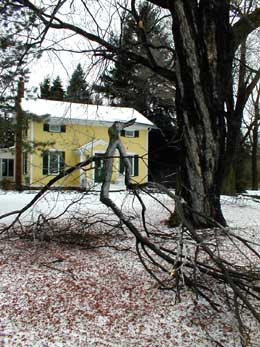
require care The ice storm of April 2003 brought power outages, damaged trees, and cleanup. The Cornell Cooperative Extension of Monroe County offers the following tips. Think safety first. Do not attempt to remove large branches on your own or go in the vicinity of trees that may be dropping more branches or may be in contact with power lines. Get certified, insured and professional help to remove downed or hanging branches. For the plant's sake it is best to wait. A tree or shrub weighed down by a coating of ice is best left alone. Moving ice-coated branches is likely to break them or cause mechanical damage from the ice itself. Often the snow or ice does not cause any breakage. Instead the weight bends the stems over. Multi-stem plants seem to be more prone to this damage than single stem plants. Many trees and shrubs will bounce back when the weight of the ice melts off. If the bending over occurs at the wrong time or lasts too long, permanent internal structural damage is done to the trees' wood. When this happens, the tree does not return to an upright position by itself. What to do after the ice melts: Pruning will certainly be important later this spring. If a branch has broken from ice loads, make a clean cut below the breakage wound as soon as possible after the ice has melted so that it can more easily heal. At that time prune properly. Do not leave stubs. Prune back to live, green, healthy wood. Prune to a bud, stem or trunk. Give a suffering plant a chance to become healthy again. Prune out only dead and severely damaged wood. Do not over-prune because the plant will need branches with good leaf tissue, to manufacture food and grow new tissues to close the wounds. During the coming season the best thing you can do for your injured tree or shrub is to avoid further stress by giving it special attention through proper watering, and mulching. provided by Brian C. Eshenaur |
